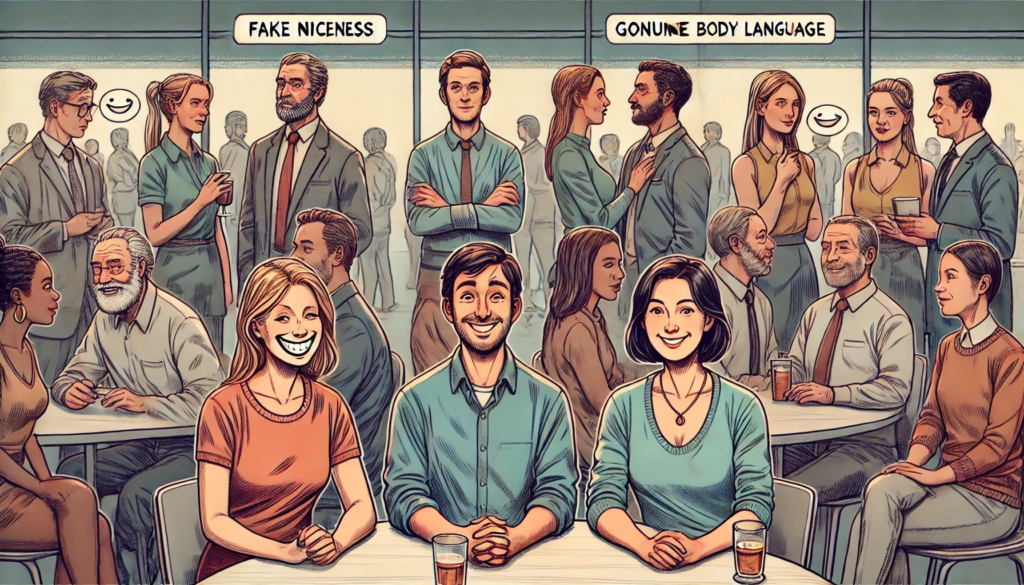
Fake niceness can be misleading and confusing, especially when trying to navigate social or professional relationships. People who exhibit fake niceness often mask their true intentions, making it crucial to identify the signs early. In this article, we explore the scientific basis behind the behaviors of fake nice people, highlighting the key signs and red flags to watch for.
Table of Contents
1. Understanding Fake Niceness: A Psychological Perspective
Fake niceness often stems from underlying psychological traits such as narcissism, Machiavellianism, or superficial charm, all of which are components of what psychologists refer to as the Dark Triad personality traits. These individuals may engage in manipulative behaviors, masking their true intentions with a façade of kindness and politeness [Paulhus, 2002].
2. Key Signs of Fake Nice People
2.1 Inconsistent Behavior
One of the primary signs of fake niceness is inconsistency. Fake nice people often display kindness when it benefits them but may quickly become indifferent or hostile when there’s nothing to gain. This erratic behavior can be a major red flag, indicating that their niceness is conditional and self-serving.
2.2 Excessive Flattery and Compliments
While genuine compliments are a normal part of positive interactions, fake nice people tend to overdo it with excessive flattery. They use compliments as a tool to manipulate or gain favor, and these compliments often feel insincere or exaggerated [Neff, 2011].
2.3 Lack of Empathy
Empathy involves understanding and sharing the feelings of others. Fake nice individuals often lack genuine empathy; their actions are not driven by a real concern for others but by a desire to appear nice. This lack of true empathetic response can manifest in dismissive or surface-level reactions to others’ emotions [Decety, 2004].
2.4 Gossiping and Backstabbing
Despite their outwardly pleasant demeanor, fake nice people are often quick to gossip or speak negatively about others when they are not present. This behavior highlights their lack of genuine respect and authenticity, and it’s a clear sign that their niceness is a front.
3. Red Flags to Watch For
3.1 Self-Centered Conversations
Fake nice people often steer conversations back to themselves, regardless of the topic. Their niceness often serves as a tool to keep the focus on their needs, achievements, or problems, rather than engaging in balanced, two-way communication.
3.2 Over-Promising and Under-Delivering
Another red flag is the tendency to make promises that they have no intention of keeping. This behavior is designed to create a favorable impression without the follow-through, revealing their true priorities.
3.3 Competitive Undercurrents
Fake nice people may exhibit competitive or envious behaviors, subtly undermining others while appearing supportive. This can manifest as backhanded compliments, passive-aggressive comments, or subtle put-downs disguised as jokes.
3.4 Inauthentic Body Language
Body language can reveal much about a person’s true feelings. Fake nice individuals might exhibit inauthentic body language, such as forced smiles, lack of eye contact, or closed-off postures. These non-verbal cues often contradict their verbal expressions of friendliness [Ekman, 2003].
4. Why People Act Fake Nice: The Motivations Behind the Mask
4.1 Social Desirability
One common motivation is the desire to be liked or accepted. In social psychology, this is known as social desirability bias, where individuals alter their behavior to conform to social expectations and gain approval from others [Fisher, 1993].
4.2 Manipulation and Personal Gain
Fake nice people may also use their charm and friendliness as a manipulative tool to achieve personal goals, whether in the workplace, friendships, or romantic relationships. This behavior is often calculated, aiming to extract some form of benefit from others.
4.3 Avoidance of Conflict
Some individuals adopt a fake nice persona to avoid conflict or confrontation. This can be a coping mechanism for managing social interactions without genuine investment, thus maintaining surface-level peace while harboring underlying discontent or disagreement.
5. How to Respond to Fake Nice People
5.1 Set Boundaries
It’s important to set clear boundaries with individuals who exhibit fake niceness. By being assertive and defining what behaviors are acceptable, you can protect yourself from potential manipulation or emotional harm.
5.2 Look for Consistency Over Time
To discern genuine niceness from the fake, observe consistency in behavior over time. Genuine people will show kindness across various situations and towards different individuals, not just when it benefits them.
5.3 Trust Your Intuition
Often, our intuition can detect when something feels off about a person’s niceness. If someone’s actions don’t match their words or if their niceness feels forced, it’s okay to trust your gut feeling and proceed with caution.
6. Conclusion
Spotting fake nice people can be challenging, but by understanding the psychological traits and behaviors that underlie their actions, you can better navigate these interactions. Recognizing the signs and red flags helps protect yourself and fosters more authentic and healthy relationships. Remember, true kindness is consistent, empathetic, and free of ulterior motives.
By staying informed and aware, you can effectively manage interactions with fake nice people and maintain positive, genuine connections in your personal and professional life.